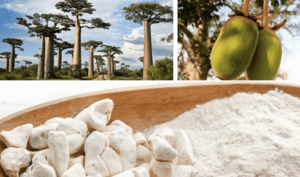The fruit of the baobab tree - monkey bread, comes from South Africa, Botswana, Namibia, Mozambique, Zimbabwe and Madagascar.
Baobab, one of the oldest trees in the world.
In Africa it is known as the tree of life.
Baobab wood is soft, fibrous. It is able to retain water and the diameter of the trunk changes depending on the amount of precipitation. When injured, the wood often exudes whitish latex, which is odorless. It produces large, heavy, putrid-smelling white flowers that are pollinated by bats at night. They occur at the end of the dry season, just before the first rains. Their peculiarity is that they last only 12 hours to bloom, they open at the end of the afternoon and develop only after dusk and fall off the next morning. The fruits are brownish or greenish in color, they look like small pumpkins with a very hard shell, they are about 20 cm long with a diameter of 10 cm. They appear about six months after the tree blooms.
The baobab fruit is the only fruit in the world that dries naturally on the branch during ripening, the baobab seeds are then harvested by hand. The baobab fruit consists of a floury white pulp containing a black seed. The seed is not consumed. The taste of this fruit is pungent and slightly sweet, it can resemble grapefruit.
It is much easier for monkeys to get to the fruit, which is often very high on the tree, hence the name "monkey bread".
The edible pulp contained inside has a sour taste. All parts of the tree can be used in the food industry, medicine or even in construction. The flesh of the fruit is used to make ice creams, drinks and also as yeast for cakes. It is very rich in various minerals, fiber and calcium. It has high acidity. This vitamin C content makes it possible to classify the product as one of the fruits richest in vitamin C after camu camu, acerola, or black currants.
A special method applied to the flesh of the fruit revealed 10 aromatic compounds, including isopropyl myristate, an unidentified phenolic compound, nonanal, safranal, geranon, decanal, octanal, linalool, another unidentified phenolic compound, and a sesquiterpene compound.
Nutritional benefits
It provides energy and is also suitable for people with gluten intolerance.
It has a high content of vitamin C (3-6 times more than oranges), antioxidants (4 times stronger than kiwi and 15 times more antioxidants than apples), calcium (2 times more than milk), contains vitamin B6 , B1, zinc, iron, phosphorus, amino acids and 6 times more potassium than in a banana, this fruit also contains a lot of pectins, which are especially important to support digestion and balance sugar levels. It also has 6 times more antioxidants than goji berries, 5 times more fiber than oatmeal. The fiber, both soluble and insoluble, found in monkey bread helps to take care of the intestinal flora and keep it healthy.
Medicinal use
Studies have shown the benefits of monkey bread in the field of medicine.
This fruit actually has anti-diarrheal, anti-inflammatory and analgesic properties, which can be beneficial for heart disease and diabetes. It is also used against stomach ailments, as a tonic, to treat arthritis, measles and smallpox, to heal wounds, or to moisturize the skin.
In humans and animals, in addition to being an immunostimulant, it helps protect the liver from chemical toxins.
The advantage of monkey bread is that its use has no contraindications.
It does not contain gluten, it is not allergenic, but in some cases it can cause temporary diarrhea if consumed in large quantities.
Due to its rich content of vitamin C and beta-carotene, baobab pulp is a real world antioxidant superfood. It protects all cellular structures from attacks by free radicals. The soluble fiber fraction facilitates the development of bacteria useful to our body, including Bifidobacterium longum, B. infantis and B. bifidum. It is an excellent regulator of the digestive tract, where the insoluble fiber has a "bandage" effect that promotes regular emptying and prevents constipation. The flesh is also an excellent rehydration agent. It is especially indicated for any convalescence, after infection, flu, bed rest, in all cases of loss of form, immobilization, surgery and the reverberation of an emotional episode.
The usage
This powder is mixed with water to make what is called Wolof in the Senegalese language, bouye juice or baak in the Serer language, a simply delicious drink, very refreshing and excellent for health.
In Senegal, this juice is made by macerating fresh fruit in water for several hours, then often mixed with sugar and a dash of milk. With hibiscus juice and Guinea black pepper coffee, it is Senegal's national drink.
This gem of nature is recommended against everyday fatigue, as a conditioning treatment. To strengthen immunity, when weakening and during convalescence. For athletes, baobab powder has a high nutritional density as well as an interesting alkaline and remineralizing power. Add it as an ingredient in drinks before and after training. As part of weight loss, it is interesting for breakfast or as a snack. The fiber will help limit feelings of hunger.
It is used to support a balanced diet in pregnant women, children and adolescents, to help reduce cholesterol levels. The intake of soluble fiber actually makes it possible to limit its assimilation in the body.
Consuming 3 g of soluble fiber per day (a spoonful of baobab powder) will lower blood cholesterol levels by approximately 10%.
How much to consume ?
The ideal amount of consumption is 30 g/day (two tablespoons).
It can be eaten throughout the year, or simply as a 21-day course in the case of a diet regimen. Its pungent taste goes very well with smoothies, yogurts, cottage cheese, compotes... It can be easily mixed with favorite drinks, fruit juices, milk, vegetable drinks (almond milk, coconut milk...).
It adds a sweet lemon note to your favorite salad dressing.
Baobab powder is best consumed raw-RAW, or combined with cold preparations in order to preserve its nutritional properties as much as possible.



Commets 0
Add a comment